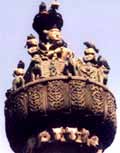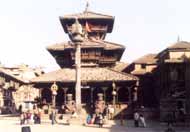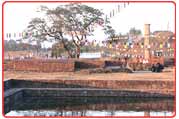|
This tour is especially made to highlight the major Buddhist
heritage sites of Nepal. For those who are curious about Buddhism,
this tour is made to provide them the opportunity to get to
know the details about Buddhism and it's culture. It takes
you to the major Buddhist pilgrimages in the valley and to
the birth place of Lord Buddha to Lumbini. In the valley you
will visit Swoyambhunath, Boudhanath listed as World Heritage
Site by UNESCO and Lumbini (birth place of Lord Buddha) out
of the valley. During the trip, visitors can see the Buddhist
devotees chanting religious hymns in their religious attire
totally devoted to Buddhism. Lumbini is known as the birth
place of Lord Buddha "The Light of Asia.". The nativity
site is marked by a stone pillar erected by Indian Emperor
Ashoka in 249 BC to commemorate his pilgrimage to the sacred
spot.
Day 01: Arrival in Kathmandu.
Upon arrival at the airport, welcome by our representative
& transfer to the Hotel. At the hotel briefing about the
program by our representative. Rest day at leisure.
Day 02: Sightseeing in Kathmandu Valley.
After breakfast, introduce with the Sightseeing Guide &
driver. We set to the first day sightseeing of Kathmandu Valley.
Today you will see the following spots, the details are as
described below:
Swoyambhunath
The four seeing eyes of Swoyambhunath Stupa watch over the
valley from the top of 77-m high hillock on western side.
This most glorious Stupa in the world, is one of the holiest
Buddhist sites in Nepal and its establishment is linked to
the creation of Kathmandu valley out of a primordial lake.
The surroundings of the Swoyambhunath are covered with small
Chaityas & monasteries as well as some Hindu temples.
The National Museum and the Museum of Natural History are
situated at the foot of the hill.
Kathmandu Durbar Square
This complex of palaces, courtyards and temples,
built between 12th and 18th Centuries, used to be the seat
of ancient Malla Kings of Kathmandu. It is the place where
kings of Nepal are crowned and their coronations solemnized.
An intriguing piece here is the 17th century stone inscription
set into the wall of the palace with writings in 15 languages.
Kumari Temple: Kumari temple is the residence of the Living
Goddess. Kumari, known as Virgin Goddess has got some specialties,
she must be chosen from a typical Newari cast with no body
marks & injuries & will be replaced by another Kumari
after puberty. Kasthamandap: Kasthamandap is believed to be
constructed from the wood of a single tree in the sixteenth
century. Situated near to the Kumari Temple. The name Kathmandu
was named after this temple.
Patan City
 Patan
Durbar Square: Patan Durbar Square is an enchanting mélanges
of Palace buildings, artistic courtyards and graceful pagoda
temples. Listed as a World Heritage Site, the former Royal
Palace complex is the center of Patan's religious and social
life, and houses a museum containing an array of bronze statues
and religious monuments. One remarkable monument here is 17th
century temple dedicated to the Hindu god Krishna, built entirely
of stone. Tibetan Refugee Camp: This camp was set up in 1960
under the initiative of the International Red Cross &
the Swiss Development Corporation in corporation with HMG
of Nepal. Its main objective is to help the Tibetan Refugees
to do something nice & support themselves & some carpet
industries & handicrafts have been operating. Patan
Durbar Square: Patan Durbar Square is an enchanting mélanges
of Palace buildings, artistic courtyards and graceful pagoda
temples. Listed as a World Heritage Site, the former Royal
Palace complex is the center of Patan's religious and social
life, and houses a museum containing an array of bronze statues
and religious monuments. One remarkable monument here is 17th
century temple dedicated to the Hindu god Krishna, built entirely
of stone. Tibetan Refugee Camp: This camp was set up in 1960
under the initiative of the International Red Cross &
the Swiss Development Corporation in corporation with HMG
of Nepal. Its main objective is to help the Tibetan Refugees
to do something nice & support themselves & some carpet
industries & handicrafts have been operating.
Day 03: Sightseeing in Kathmandu Valley.
After breakfast set for another day's sightseeing:
Boudhanath
This Stupa lies 6-km downtown Kathmandu. This
colossal and ancient Stupa, one of the biggest in the world,
has the all-seeing eyes of Lord Buddha. It was built in the
fifth century AD. It is built on an octagonal base inset with
prayer wheels. One can observe devotees chanting religious
hymns & playing with prayer wheels.
Pashupatinath Temple
Situated 5 km east on the bank of sacred Bagmati
River, the temple of Lord Shiva with two-tiered golden roof
and silver doors is famous for its superb architecture. Chronicles
indicate the temple's existence prior 400 AD. Devotees can
be seen taking ritual dips in the holy Bagmati River
Bhaktapur City
 Durbar
Square: As you walk in, you can not but be overcome by a feeling
of inner harmony. Such is the art and architecture and the
special layout here. The 15th century Palace of 55 windows,
situated to the left as you enter through the city gate, inspires
admiration. The National Art Gallery is also situated inside.
The Palace Entrance, Golden Gate that is the entrance to the
main courtyard of the Palace of 55 windows, is masterpiece
in repousse art. In front of the palace building is a medley
of temples of various designs. There are temples like Batsala
Temple and the Shiva temple, the replica of Pashupatinath
Temple etc. Nyatapola Temple: This five story pagoda was built
in 1702 AD. Each story has pair of figures (two wrestlers,
two elephants, two lions, two griffins and goddess's tigress
& & lioness). This temple is one of the tallest pagodas
& famous for its massive structure and subtle workmanship. Durbar
Square: As you walk in, you can not but be overcome by a feeling
of inner harmony. Such is the art and architecture and the
special layout here. The 15th century Palace of 55 windows,
situated to the left as you enter through the city gate, inspires
admiration. The National Art Gallery is also situated inside.
The Palace Entrance, Golden Gate that is the entrance to the
main courtyard of the Palace of 55 windows, is masterpiece
in repousse art. In front of the palace building is a medley
of temples of various designs. There are temples like Batsala
Temple and the Shiva temple, the replica of Pashupatinath
Temple etc. Nyatapola Temple: This five story pagoda was built
in 1702 AD. Each story has pair of figures (two wrestlers,
two elephants, two lions, two griffins and goddess's tigress
& & lioness). This temple is one of the tallest pagodas
& famous for its massive structure and subtle workmanship.
Day 04: Drive Kathmandu-Lumbini.
Drive to Lumbini, the birthplace of Lord Buddha. About 7-8
hrs drive. Drive passes through the bank of the famous rivers
of Nepal, enjoying the natural beauties; green forests &
gorges, after 4 hrs, the drive enters into lowland of Nepal
where the roads are straight & wide. Upon arrival in Lumbini.
Check in to the hotel & rest days at free.
 Day
05: Lumbini. Day
05: Lumbini.
Visit the birthplace of Lord Buddha, the apostle of peace,
compassion & non-violence. Here one can see the broken
Ashok pillar, remnants of an old monastery, images of Buddha's
mother Maya Devi etc. are still preserved in Lumbini. Visit
sacred Garden where Buddha was born, Mayadevi Temple, and
Puskarni Pond where Buddha's mother had taken a bath before
giving birth to Buddha. Visit different monasteries, which
represent different countries like Myanmar Temple, China Temple,
Korean Temple, Nepal Buddha Temple etc.
Day 06: Drive
Lumbini-Kathmandu.
Drive back to Kathmandu. Rest day free for shopping.
Day 07: Departure
to onward destination.
|


